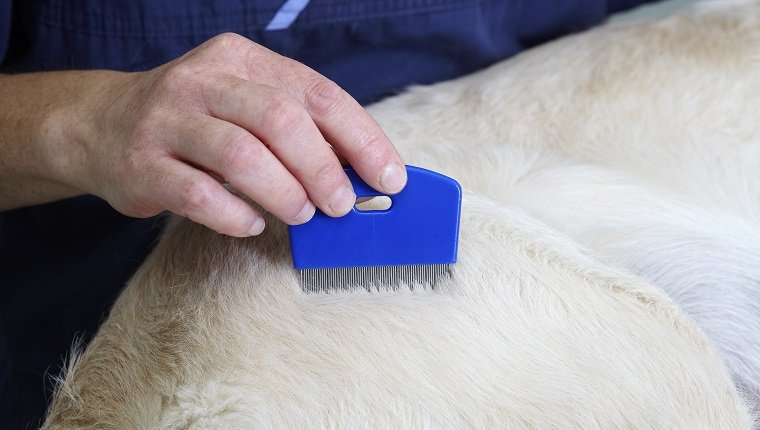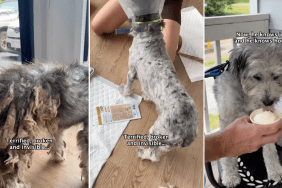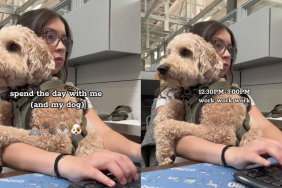Flea bites cause nasty itches for dogs and lead to secondary skin conditions. Infestations are a common problem, so it’s important for every dog parent to know how to get rid of them.
Luckily, there are several home remedies that can help get rid of fleas on your dog, kill fleas that have infested your home, and prevent fleas from entering your environment again. You should know what a flea infestation looks like, including the insects, their eggs, and their bites.
Once you’re sure your dog has fleas, you should begin treatment for bites and work on ridding them from your home in addition to taking preventative measures to make sure they don’t come back.
Here’s what you should know about fleas and their bites, and how to get rid of them.
What Do Fleas, Flea Eggs, & Flea Bites Look Like?
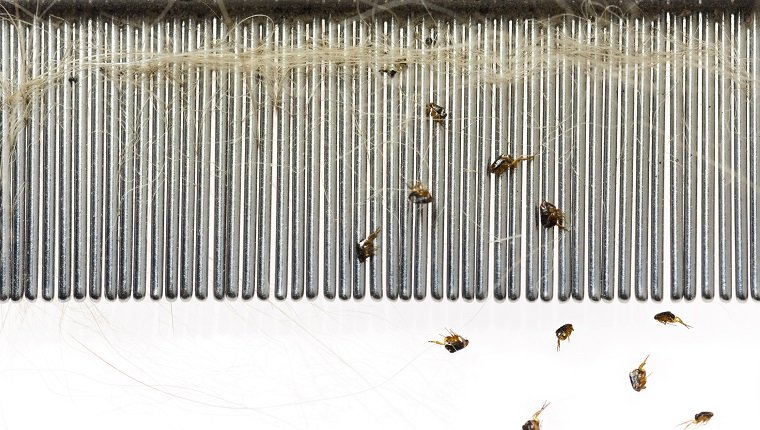
Adult fleas are visible to the naked eye, but they are fast and can easily hide in your dog’s fur. They’re usually brown or reddish brown in color and have six legs.
Though they don’t have wings, they can jump very far, which is why you should be careful when examining your dog so the fleas don’t jump to your skin or hair.
Look For Flea Dirt
Because fleas are so small and quick, you may be able to spot what is known as “flea dirt” more easily. Flea dirt is the feces of fleas. It may look like tiny grains of pepper or flecks of dirt.
You can find it fairly easily on dogs with light colored fur, but it may be more difficult to spot against dark fur. To confirm that it is flea dirt and not ordinary dirt, you can run a comb through your dog’s coat, which should pull some of the dirt off and possibly some adult fleas, as well.
Place the residue on a wet paper towel. Flea dirt will appear to have a rust color as it dissolves because it contains traces of blood, while regular dirt will be black or dark brown.
Look For Flea Eggs
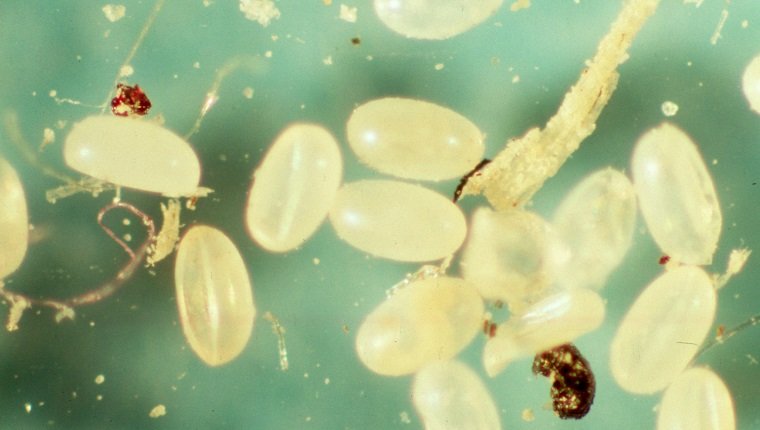
Flea eggs are clear and shaped like small ovals that are tinier than a grain of sand. They are laid in clusters of about 20, though you aren’t likely to see them on your dog. They mostly fall off your dog’s fur, so you may be more likely to spot them in your dog’s bed or favorite places to relax.
After a few days, they hatch. Then, after feeding on blood, they enter the pupal stage where they form a kind of cocoon that is very sticky and protects them from chemicals that you might use to kill them.
Fleas in the pupal stage are the most difficult to get rid of.
Look For Flea Bites
Flea bites appear, like other insect bites, as small red lesions. It can be difficult to tell them apart from other bites, though there are a few signs that indicate fleas are the cause of the lesions.
Mosquito bites tend to be solitary and appear mostly at dusk when the insects are most active. Flea bites can occur in clusters and at any time of day.
Tick bites are often accompanied by an actual tick that has latched on or look like a bulls-eye and are more elevated. Fleas do not latch on for a significant amount of time to feed, and bites are less likely to be as elevated.
The most common places that flea bites appear are on the groin, hind legs, and the back between the ribs and the tail.
Itching Can Be A Sign, But Not Always
If your dog is itching, it can be a sign of fleas. Dogs are actually allergic to the saliva of fleas, which is the cause of the itching.
Some dogs, however, are not allergic to flea saliva and will show no signs of itching.
Just because your dog isn’t scratching, licking, or chewing doesn’t mean they’re flea free.
How To Treat Flea Bites On Dogs

It’s important to note that you should treat the flea infestation to get rid of the fleas before you begin treating the bites. If fleas are still present, more bites will appear.
The symptoms of flea bites, like redness and itchiness, are the result of an allergic reaction. Therefore, flea bites should be treated with medication that suppresses allergies, such as antihistamines or topical steroids.
You may need to treat secondary skin infections that happen because of the bites or wounds from scratching with antibiotics.
There are also natural, homemade solutions that can help combat allergies and the symptoms of flea bites. Here are a few that might help:
- An oat bath can be very soothing for itchy skin and help remove other allergens from the coat.
- Quercetin is a compound derived from fruit that has anti-inflammatory and antihistamine properties.
- Aloe vera has anti-inflammatory properties and can cool and sooth itchy spots, though you should make sure your dog doesn’t lick it off.
- Coconut oil can suppress inflammation and is known to reduce the allergic reaction to fleas.
You must consult your veterinarian for proper use of these solutions.
Home Remedies For Flea Infestation In Dogs

There are several home remedies that can work to get rid of the flea infestation on your dog, kill the fleas and larva in your house, and prevent them from coming back.
Homemade Flea Repellents
To get rid of fleas on your dog, you may want to start with apple cider vinegar. This won’t kill fleas, but it will make them jump off of your dog.
You can create a mixture of two parts apple cider vinegar and one part water in a spray bottle or dip a comb in the mixture and comb the fleas out. Avoid open wounds with this one.
Aloe vera and cayenne pepper can also be mixed to create a topical solution that fleas hate. Make sure to avoid the eyes and open wounds, and if your dog is going to lick it off, it may be best to skip this treatment or use an Elizabethan collar.
Citric acid is a natural flea killer, and you can create a mixture by boiling a lemon and letting it soak overnight. You can use this in a spray bottle or to wash your dog’s bedding to get rid of fleas hidden inside. Again, avoid the eyes and wounds.
Lavender is another solution, as fleas hate it. You can let it soak overnight in water to create a spray that will repel fleas.
Get Rid Of Fleas In Your Dog’s Environment
As you rid your dog of fleas, don’t forget that you must also rid your home of them, too.
Finely ground salt can be spread over the carpet and furniture to dry fleas out and kill them. It should be left for two days before vacuuming it up. Don’t leave it on for longer or your carpet will get wet and musty, especially in humid areas.
Salt can also be mixed with water to clean hard surfaces.
Perhaps one of the best ways to kill fleas left in carpets or furniture is to use diatomaceous earth. It’s a natural rock formed by fossilized algae, and it’s very fine and abrasive to the exoskeleton of fleas. It dehydrates them, and unlike chemicals, fleas don’t develop an immunity to it.
Diatomaceous earth should be spread evenly over surfaces and vacuumed up after two to three days, but avoid using it on your dog’s skin, as it can dry them out.
You can prevent fleas from coming back with cedar chips. Fleas hate them. Spread them around your outdoor area and around your dog’s bed. Cedarwood oil can be mixed with a drop of alcohol to make a natural flea collar with a bandanna.
Rosemary can also be ground up and sprinkled around to repel fleas.
Other Ways Of Getting Rid Of Fleas & Preventing Them
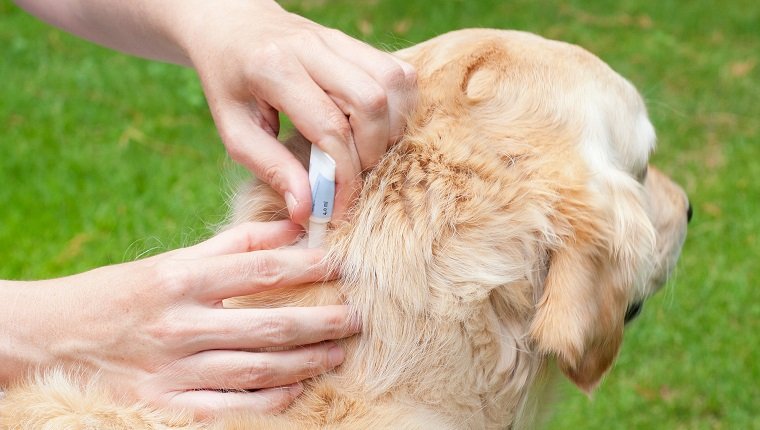
There are medications available, including spot-on treatments that are made with chemicals that kill fleas or break their life cycle so they die off.
Often these are prescription treatments, and though they are effective at removing fleas, they may come with some side effects. Monthly treatments will help to prevent flea infestations.
Flea shampoos, powders, sprays, and collars are also available. You should always check the ingredients and instructions before using these with your dog. Make sure that you are aware of any possible side effects that may occur.
These are usually good for treating flea infestations in the short term, but may not be effective as long-term solutions.
Bug bombs and other products are available for the home from exterminators, and they’re not cheap. They also use a lot of chemicals. Insecticides are available for outdoor use, as well.
You must ask your veterinarian about all solutions for flea infestation, including natural solutions, before you proceed with treatment.
No matter what solutions you use to treat a flea infestation, you should always vacuum and clean your home, and be sure to wash your dog’s bedding and any furniture your dog sleeps on. Be thorough, as fleas can get deep into fabrics and stick there for a long time.
Has your dog ever had fleas? How did you treat the infestation? Let us know in the comments below!
